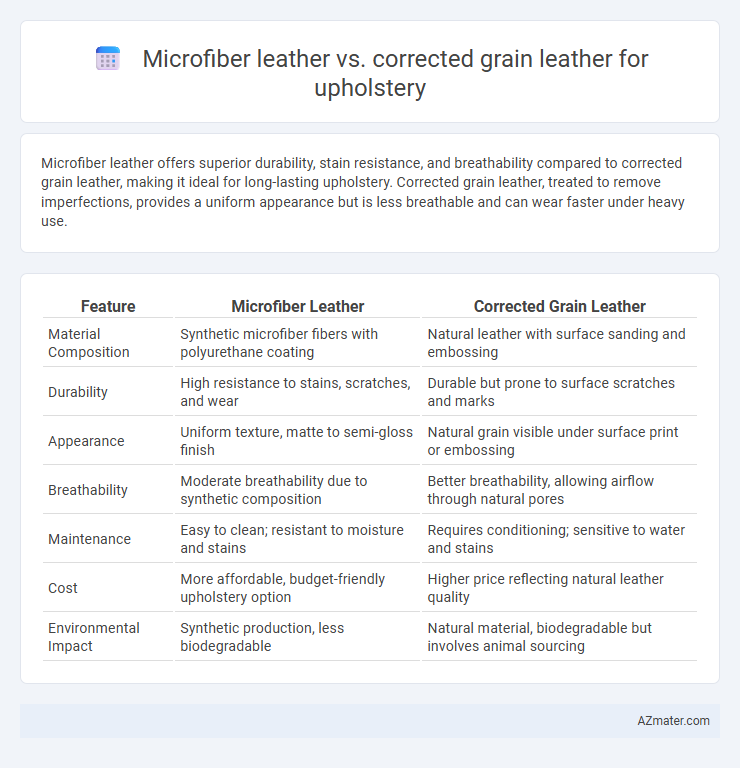Microfiber leather offers superior durability, stain resistance, and breathability compared to corrected grain leather, making it ideal for long-lasting upholstery. Corrected grain leather, treated to remove imperfections, provides a uniform appearance but is less breathable and can wear faster under heavy use.
Table of Comparison
| Feature | Microfiber Leather | Corrected Grain Leather |
|---|---|---|
| Material Composition | Synthetic microfiber fibers with polyurethane coating | Natural leather with surface sanding and embossing |
| Durability | High resistance to stains, scratches, and wear | Durable but prone to surface scratches and marks |
| Appearance | Uniform texture, matte to semi-gloss finish | Natural grain visible under surface print or embossing |
| Breathability | Moderate breathability due to synthetic composition | Better breathability, allowing airflow through natural pores |
| Maintenance | Easy to clean; resistant to moisture and stains | Requires conditioning; sensitive to water and stains |
| Cost | More affordable, budget-friendly upholstery option | Higher price reflecting natural leather quality |
| Environmental Impact | Synthetic production, less biodegradable | Natural material, biodegradable but involves animal sourcing |
Introduction to Microfiber Leather and Corrected Grain Leather
Microfiber leather is a synthetic material engineered from ultra-fine polyester fibers, offering high durability, stain resistance, and a soft, breathable texture ideal for upholstery. Corrected grain leather is genuine leather that has undergone sanding and buffing to remove imperfections, then coated with a synthetic layer to enhance uniformity and protection. Both materials provide distinct benefits for upholstery, with microfiber leather excelling in maintenance and corrected grain leather showcasing authentic leather appearance and resilience.
Material Composition and Manufacturing Process
Microfiber leather consists of a synthetic polyester and polyamide fiber base combined with a polyurethane coating, mimicking natural leather's texture and durability while offering enhanced stain resistance. Corrected grain leather is made from split leather surfaces that are buffed and coated with pigments, dyes, and finishes to conceal imperfections and create a uniform appearance. The manufacturing process of microfiber leather involves synthetic fiber weaving followed by a polyurethane application, whereas corrected grain leather undergoes sanding, embossing, and topcoating to improve aesthetics and durability for upholstery use.
Aesthetic Differences: Texture and Appearance
Microfiber leather features a smooth, consistent texture that mimics natural leather while offering enhanced durability and stain resistance, making it ideal for modern, sleek upholstery designs. Corrected grain leather displays a more traditional look with a slightly embossed surface that masks imperfections but retains the authentic grain pattern beneath, lending a classic and rich aesthetic. The choice between these materials often hinges on whether a uniform, contemporary appearance or a timeless, textured finish is desired for the upholstered furniture.
Durability and Wear Resistance
Microfiber leather offers superior durability and wear resistance compared to corrected grain leather due to its synthetic fiber composition and tight weave, which resists scratches and stains effectively. Corrected grain leather undergoes sanding and buffing to remove imperfections, but this process compromises its natural fiber strength, making it less resistant to abrasion over time. For upholstery applications demanding long-term resilience and minimal maintenance, microfiber leather proves to be a more robust and enduring choice.
Comfort and Breathability
Microfiber leather offers superior breathability and comfort compared to corrected grain leather due to its finely woven synthetic fibers that enhance air circulation and moisture absorption. Corrected grain leather, while durable and visually uniform, tends to trap heat and moisture, reducing breathability and comfort during prolonged use. For upholstery applications prioritizing comfort, microfiber leather provides a cooler, more breathable seating experience that resists sweat buildup.
Maintenance and Cleaning Requirements
Microfiber leather offers superior resistance to stains and moisture, requiring only mild soap and water for routine cleaning, making it highly low-maintenance compared to corrected grain leather. Corrected grain leather, treated to remove imperfections, demands specialized leather cleaners and conditioners to maintain its appearance and prevent cracking over time. The durability and ease of upkeep make microfiber leather a more practical option for upholstery in high-traffic or spill-prone environments.
Environmental Impact and Sustainability
Microfiber leather, made from synthetic fibers like polyester and polyurethane, offers a lower environmental footprint due to its durability, resistance to wear, and reduced need for frequent replacement compared to corrected grain leather derived from animal hides. Corrected grain leather undergoes extensive chemical treatments and finishes, increasing water and energy consumption as well as chemical waste in its production process, raising sustainability concerns. Choosing microfiber leather for upholstery supports resource conservation and reduced ecological impact while maintaining comparable aesthetic and functional qualities to traditional leather.
Cost Comparison and Value for Money
Microfiber leather offers a cost-effective alternative to corrected grain leather, with prices typically 30-50% lower while maintaining durability and stain resistance ideal for upholstery. Corrected grain leather, though more expensive, provides a more authentic leather feel and greater longevity, justifying its higher upfront cost for premium furniture. Choosing microfiber leather maximizes value for money in budget-conscious projects, whereas corrected grain leather delivers superior investment returns through enhanced aesthetics and durability.
Applications in Upholstery: Best Use Cases
Microfiber leather offers exceptional durability and stain resistance, making it ideal for high-traffic upholstery in commercial spaces and homes with children or pets. Corrected grain leather, with its uniform texture and polished finish, is best suited for luxury furniture where aesthetics and a classic leather feel are prioritized. Both materials excel in upholstery, but microfiber leather outperforms in maintenance and longevity under heavy use, while corrected grain leather provides a premium look for formal or decor-centric settings.
Conclusion: Choosing the Right Leather for Upholstery
Microfiber leather offers superior durability, stain resistance, and ease of maintenance, making it ideal for high-traffic upholstery in homes with children or pets. Corrected grain leather provides a classic leather appearance with enhanced scratch resistance but requires more care and conditioning over time. Selecting the right leather depends on balancing aesthetic preference with practical considerations like durability, maintenance, and cost for your specific upholstery needs.

Infographic: Microfiber leather vs Corrected grain leather for Upholstery
 azmater.com
azmater.com